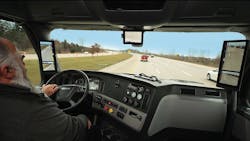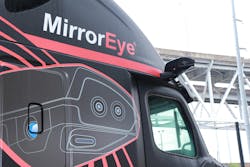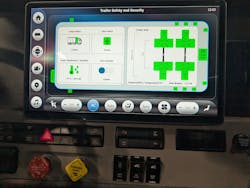For more on cameras in the truck:
One of the first things you were probably taught as a student driver was to check your side and rearview mirrors. With the rapid onset of mirrorless camera systems, not-so-distant future generations will find this as antiquated as dialing a rotary telephone or renting movies on VHS. These systems, which comprise an array of cameras around the vehicle that feed high-definition video of traffic and objects onto monitors inside the cab, are meant to offer a wider and clearer view of what’s behind and to the side of the driver than traditional mirrors.
It’s hard to predict when passenger cars will fully adopt the technology, which is already more than a decade old; but in heavy-duty trucking, it’s already happening. Stoneridge, the premier developer of these camera systems, has offered MirrorEye as an aftermarket solution for several years and now has deals in place to be factory installed on Fifth Generation Freightliner Cascadias and the All-New Volvo VNL. The Freightliner version is called MirrorCam and Volvo calls it the Camera Monitor System (CMS).
A big reason these OEMs are integrating the mirrorless cameras during assembly is safety. MirrorEye allows tractor-trailer drivers to see things typically hidden in their blind spots while changing lanes on the highway or backing into a loading dock.
“Drivers have 40% more visibility just based on the cameras versus what they would have in their traditional mirror,” explained David Kracirik, Stoneridge director of North American fleet sales. “And then they have access to tools to help them tackle different challenges when they’re driving, like enhanced night vision.”
The cameras use focused infrared light for night driving and backing up into dark places, he added. Automatic panning, meanwhile, keeps the back of the trailer in view during turns. “That way they can see what’s always in between the front of their tractor and the end of their trailer,” Kracirik said.
The cameras also have a breakaway feature that folds if a driver smacks them on a wall, post, or other object. An internal motor allows the driver to remotely return the armature to normal position with a switch. This feature will not be available on MY2025 Freightliners, but Volvo said the VNLs will have it.
Because these cameras are usually the sole way for drivers to see to the side and rear, the external cameras have also been built with heating elements to prevent frost buildup and a hydrophobic coating to repel water.
“As with any new technology, there is some level of skepticism by drivers, but that typically goes away once they’ve had time to adapt to the [CMS] and see the many benefits it offers,” offered Kyle Zimmerman, public relations manager for Volvo Trucks North America.
While OEMs are just starting to standardize the driver-assistance technology, several fleets have chosen to install these aftermarket safety systems throughout the first half of the decade. KLLM Transport Services and Frozen Food Express, both owned by brothers Thomas and James Duff, started spec’ing the device on all new trucks in 2023.
“Throughout the validation period, our drivers have told us that the reduction of blind spots, better night vision, and visibility in inclement weather situations, along with the ability to see the end of the trailer consistently through turns, have made operations less stressful and, most importantly, safer,” said Wilson Risinger, VP of safety for KLLM and FFE, at the time.
Risinger also noted a slight improvement in fuel efficiency—1%— when the large rectangle exterior mirrors are replaced with the sleek roof-mounted MirrorEye cams, allowed by an FMCSA waiver. This exception was renewed last year until 2029.
“We are still required by law to sell trucks with smaller, cab-mounted support mirrors in North America and cannot sell them with CMS only at this time,” Zimmerman explained.
Safety is what fleets truly have their eye on, and Kracirik said in a study sampling 160 million miles driven with the system, the average cost reduction due to collisions was $13,000 per 1 million miles. Even when collisions occurred, they were much less severe, he said.
“The driver just had that much more time to make a decision when they were merging or changing lanes,” Kracirik explained. “Or they had just a few more seconds when they were backing up to see an object.”
Continuous improvement
MirrorEye is on its second iteration, and the aftermarket version can record video to a DVR, which can send 10 minutes of video to fleet managers via a dedicated dongle. The system relays diagnostic and fault code data from the FA 470 telematics device. Information can be tracked through the My Stoneridge app.
Software updates in the last few years have improved how the backup fail-safe camera activates if the primary system goes down. Kracirik teased that an “enhanced diagnostics feature is coming in the next few months.”
“[Fleets will] get notified proactively before the driver actually sees an issue,” he said. “And then those DTCs actually come with very detailed resolution steps from our customer service team.”
The factory-installed camera systems are fully connected into the OEMs’ diagnostic system and can self-diagnose if a cable breaks or a camera goes out and alert the driver that maintenance is needed, Stoneridge CTO Troy Cooprider said.
Stoneridge also has “a pretty extensive fault tree analysis that all our technicians have access to,” along with a 24-hour customer hotline, to better aid drivers in case of technical problems.
A connected trailer partnership with Grote launched in 2024 has also led to additional visibility of the road and overall tractor-trailer health. With the aid of trailer-mounted cameras, the system provides a better rear view. A dynamic overlay appears on the monitor to help a driver know where they will end up on their current reverse angle.
“The goal of that was to provide that rear trailer view and trailer data to the driver in real time all through the J560 connector,” said Mario Gafencu, Stoneridge product design/evaluation specialist.
Maintenance
When MirrorEye was new and upfitters were less familiar with how to install the cables, Kracirik said they could become loose or pinched. Like any video cables, that could affect the feed on the monitors. That is not a common problem anymore, according to Stoneridge.
He cautioned that technicians should be careful, though, when working near the equipment in the cab and around the A-pillar. “Those video coax cables are sensitive, so just be careful as you’re repairing other things in the overhead,” Kracirik said. “Don’t zip tie them too tight; don’t 90 degree them.”
Fleets should also train drivers, especially in sleepers, not to lean on or hang clothing or gear on the monitors. Trying to shift the monitors is also a major no-no.
“Those are not adjustable unless you loosen them up,” he warned. “A lot of drivers will want to point the monitor a little bit more to the left, so they’ll grab it and then end up breaking it.”
Stoneridge offers various levels of training for fleets to ensure they know all this before getting on the road.
“Our head of service will essentially give a virtual training on what are the most common things to repair,” Kracirik said. Depending on fleet size and number of units ordered, Stoneridge will also provide on-site training on updating ECUs, swapping rigs and cables, and if the external camera were to hit something too much for even the breakaway feature to withstand.
These cameras may serve as an excellent lookout, but it’s still up to the driver, after all.
About the Author

John Hitch
Editor-in-chief, Fleet Maintenance
John Hitch is the award-winning editor-in-chief of Fleet Maintenance, where his mission is to provide maintenance leaders and technicians with the the latest information on tools, strategies, and best practices to keep their fleets' commercial vehicles moving.
He is based out of Cleveland, Ohio, and has worked in the B2B journalism space for more than a decade. Hitch was previously senior editor for FleetOwner and before that was technology editor for IndustryWeek and and managing editor of New Equipment Digest.
Hitch graduated from Kent State University and was editor of the student magazine The Burr in 2009.
The former sonar technician served honorably aboard the fast-attack submarine USS Oklahoma City (SSN-723), where he participated in counter-drug ops, an under-ice expedition, and other missions he's not allowed to talk about for several more decades.


